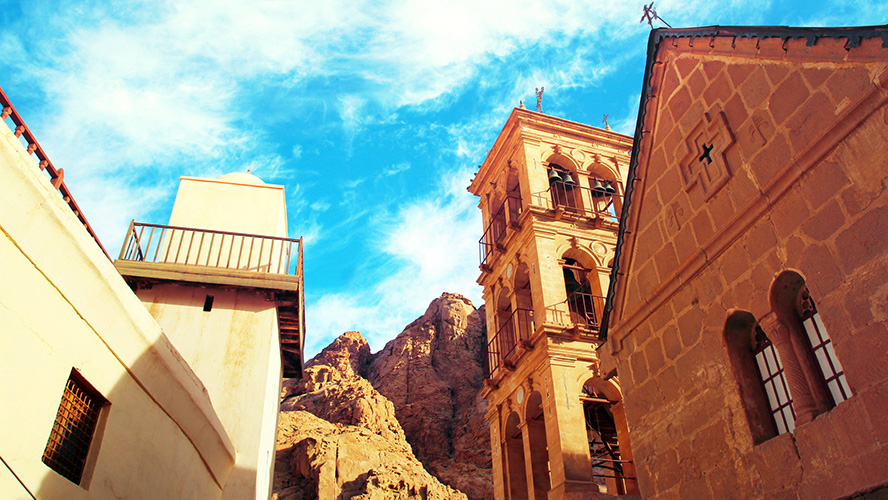There are places that are spectacular due to their natural beauty or architecture, and others because of a spiritual or historical significance that makes them unique. In the case of St Catherine’s Monastery, all three elements come together: the striking landscape of Mount Sinai, the stone structure of the oldest inhabited convent in the world and the fact that it was built on the site where Moses is said to have found the burning bush through which God appeared to him.
History and context
St Catherine’s Monastery was founded in the 6th century at the foot of Mount Sinai, right where tradition has it that Moses saw the burning bush and spoke to God, which is why it’s also known as the Monastery of the Burning Bush.
The first chapel was built by order of Emperor Constantine I’s mother, St Helena, but it was the Byzantine emperor Justinian I who commissioned the construction of a three-aisled basilica, which remains the main part of the monastery today. In fact, inscriptions honouring Justinian and his wife Theodora can be seen in the easternmost part on some of the columns.
Its strategic location at the foot of a mountain sacred to both Christians and Jews made it a centre of study for monks and a place of pilgrimage for believers, making it the oldest inhabited monastery in the world.
The outer structure has impressive fortified walls up to 19 metres high that protected manuscripts, works of art and the monks themselves from foreign attack, while the church preserves Byzantine mosaics and frescos. A World Heritage Site, this Christian centre is now overseen by the Orthodox Church of Sinai, which is under the authority of the Orthodox Church of Jerusalem, and possesses an enormous wealth of library material. Remains of a 10th-century mosque have even been found during various archaeological excavations.
How to visit it
The best way to reach the monastery is by car or bus. There are many excursions from Sharm El Sheikh that go to and return from the monastery in the same day. St Catherine’s Monastery is around a two-hour drive from the Red Sea resort town of Sharm El Sheikh and a three-hour drive from Nuweiba.
This incredible monument is open every day except Fridays, which is a holy day for Muslims, as it’s located in Egypt, a predominantly Muslim country. It’s also closed on Sundays, the Lord’s Day for Christians.
You can visit it from 9:00 to 17:00 during the rest of the week, though opening times may vary on religious holidays, so it’s best to check before you go. You need to get a ticket at the monastery itself, unless on an organised tour. Keep in mind that they don’t always accept credit cards, so it’s a good idea to bring cash.
What is there to see
There are three main attractions within the monastery in addition to its calm, spiritual atmosphere. The first is the Basilica of St Catherine, also known as the Basilica of the Transfiguration. This section dates back to the time of Justinian, with five side naves crowned on the western side by towers and a bell tower that was added later. One fascinating detail is that the bells that ring were a gift from Tsar Alexander II. Don’t miss the elaborate decorations in the chapel and the wooden ceiling and gate, which date back to the 6th century.
The monastery is a masterpiece not just on the outside but also for it holds: almost 5,000 beautifully decorated manuscripts, books and codices dating back 17 centuries. It’s considered the oldest library in the world and the most significant for Christianity after the one in Rome. The desert climate has kept them in excellent condition.

Alongside the sacred books, there are first editions of works by Homer, Aristophanes and Plato, produced between the late 15th and early 16th centuries.
While the library isn’t always open to visitors, the Museum of Icons usually is. You can see precious mosaics, chalices, reliquaries and crucifixes there, most of them of Byzantine origin. The 7th-century Sinai Pantocrator, regarded as one of the most realistic portraits of Jesus of Nazareth, is a particularly striking example.
The third key site is where tradition has it that the Burning Bush appeared, said to have sprouted from a cutting in the courtyard of the ancient monastery. Beside it is the Holy Well, where Moses is believed to have drunk water before continuing his journey through the desert.
Interesting facts and curious features
Since this is a holy place, you should dress modestly, covering your shoulders and knees. You’ll also need to pass through several security checks, as security measures were heightened following an attack in 2017.
The monastery is filled with holy sites for both Jews and Christians. The monks, who have lived there since the 6th century, have an excellent relationship with the Bedouin tribes of Sinai. Collaboration between the communities here is very strong.
It’s also worth noting that the monastery observes certain religious festivals and pilgrimages, so keep these in mind when planning your visit.












































































